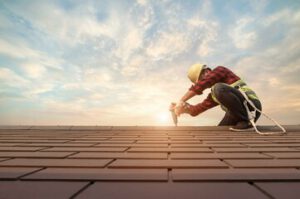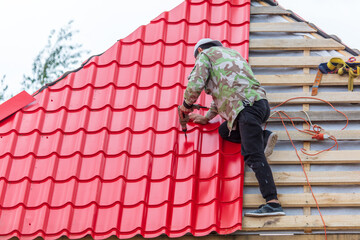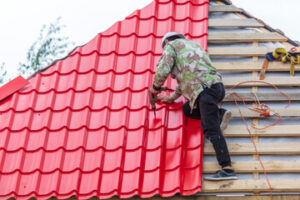A roof is a part of a building that covers and protects against rain, snow, sunlight, extremes of temperature, and wind. Roofing materials and construction techniques are widely varied. They compete in terms of construction features, heat flux reduction, cost, maintenance, appropriate climate, and preferred building types. The main structural components of a roof are rafters and trusses. Atop these are sheathing boards of a type such as plywood or OSB.
Colorado Springs Roofing insulation helps keep your home warm in the winter and cool in the summer. It also provides acoustic benefits and can reduce unwanted noise transfer between rooms. It is available in a variety of forms and R-values to fit your specific needs and budget.
Some types of insulation can be DIY projects, while others require professional installation. Always read product labels and manufacturers’ fact sheets for important information such as R-values, which are measurements of thermal resistance. The higher the R-value, the greater the insulating power.
The type of insulation you select depends on several factors, including your home’s existing insulation level, your climate, and your budget. You can use a R-value calculator to determine your home’s current and recommended R-values.
Blown-in insulation is blown in place using a machine that resembles an air compressor. It is typically made from fiberglass, rock wool, or reclaimed cellulose material (such as recycled newspapers and cardboard). It can be placed in difficult-to-reach areas such as attic joists and rafters. It has a high R-value, is fungus-resistant, and is mold and mildew-resistant.
Fiberglass blankets and batts are the most common forms of residential insulating materials, and they can be installed in many locations in your home. This includes attics, walls, basements, crawl spaces, and floors. Some are made with fire-resistant material, making them a good choice for fireplaces and wood stoves.
There are some products that combine bulk and reflective insulation, such as reflective foil-faced roofing blankets. They help lower cooling bills by reflecting radiant heat away from the home during the summer and reducing condensation during the winter.
Under-roof insulation, usually made of a breathable synthetic fabric or paper, prevents water backup beneath the shingles and stops damage from ice damming and windy rains. It can also protect the wood fascia from rot and stop rodent entry and nesting. It is used in conjunction with counter, apron, and step flashings and can be applied to walls and curbs.
Structural insulated panels, or SIPs, are a major advancement in post-and-beam and timber-frame construction. They consist of plywood or oriented strand board (OSB) glued to a foam core made of expanded polystyrene, polyurethane, or polyisocyanurate. They are a popular alternative to standard framing and can be used for ceilings, walls, and roofs. They are designed to be easy to install and offer a number of advantages, including superior strength and insulating values, plus the ability to run electrical wiring, plumbing pipes, and water heaters through them.
Waterproofing
Roofing is a vital part of any building that provides shelter, safety, and insulation to the people in it. Without proper waterproofing, a roof may leak and cause serious damage to the building and its occupants. Waterproofing is a process that uses flexible membranes to seal the surface of a roof and prevent moisture penetration. The membranes can be applied to flat or sloped roofs. They are often made from rubber, asphalt, or ethylene-butylene rubber (EPDM). Several different types of membranes are available for waterproofing. Some are prefabricated and rolled onto the roof. Others are installed as an overlay on existing roofing material. Whether you choose prefabricated or liquid-applied roofing, it is important to select the right membrane for your needs.
The waterproofing membrane should be breathable to keep moisture inside the space, but it should also be impermeable to prevent water from seeping in from outside. It should also be resistant to abrasion and corrosion. For example, a roof that is exposed to sunlight should use an EPDM membrane that is UV-resistant. It should also be able to withstand high temperatures and ozone exposure.
A vapor retarder can be added to the waterproofing membrane to slow down the rate at which moisture is released from the concrete. This is useful in areas that may experience freeze-thaw cycles. It can also be useful for buildings that will be occupied for long periods of time, since the slower release of moisture can help reduce mold and mildew growth.
Some types of waterproofing can be applied in one coat, while others require two or more coats. The best option for you depends on the type of roof you have and how much work you want to do yourself. Liquid rubber is a good choice for most flat roofs, as it is easy to apply and durable. It is also a good choice for a dormer roof because it can be flexed to fit the unique shape of the structure. Before applying the liquid rubber, be sure to prime the surface. This will make it easier to clean and improve adhesion.
Durability
When a facility manager chooses a roofing system, she is not only looking for the best value, but she also wants a durable system that will last. After all, no one looks forward to re-roofing projects. They are messy, disruptive, and expensive. However, a well-performing roof can pay dividends to an organization.
Many different roofing materials are available. In general, the longest-lasting roofs are made from concrete and clay tiles. These outperform asphalt shingles and metal roofing. In fact, these types of roofs can last 50 years or more.
These long-lasting roofs are generally more expensive than shingle or metal systems. This is why it’s important to carefully select a roofing material in conjunction with the building’s architecture and climate conditions.
Most people consider roofing durability when selecting a new roof. After all, they want to get the most bang for their buck and expect to live in the house for decades. Choosing the wrong roofing material can cost the homeowner a lot of money over time due to frequent repair and replacement costs.
Durability is becoming increasingly important when evaluating green buildings and roofing choices. Hoff says this is a result of the growing recognition that it is not enough to look good immediately; building designers need to be sure the roofing choice will hold up over the life of the structure and will not become a costly landfill burden in 10 or 20 years.
Another reason for the increased focus on durability is the increasing emphasis on sustainability. The sustainable building movement has long demanded that the major sub-systems of a structure (including the roof) last for 60 or more years.
This is a significant challenge, as roof maintenance is often given little attention. Even a high-performing roof cannot last its expected lifespan if it is regularly ignored. However, there are a number of steps that can be taken to maximize roof performance and durability, including installing redundant laps and seams, using sacrificial layers around vents that exhaust oils or chemicals, and adding an extra coating layer.


 A roof installed correctly can last for decades and provide a long-term investment. It will protect your home from the elements and help you save money on energy bills. It also offers aesthetic benefits and will enhance the overall look of your property. Metal roofing installation is a complex process that requires professional expertise. It involves a wide range of materials, techniques, and tools. Whether you are a homeowner or a professional, it is important to do your research and plan ahead.
A roof installed correctly can last for decades and provide a long-term investment. It will protect your home from the elements and help you save money on energy bills. It also offers aesthetic benefits and will enhance the overall look of your property. Metal roofing installation is a complex process that requires professional expertise. It involves a wide range of materials, techniques, and tools. Whether you are a homeowner or a professional, it is important to do your research and plan ahead.